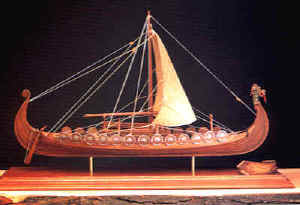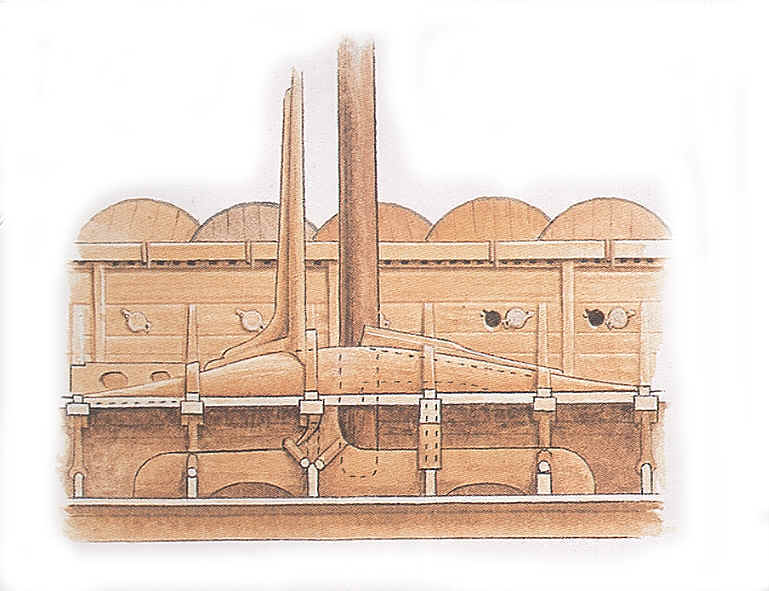|
Gokstad Viking Ship
Construction Methods Page 2
The caulking was mainly done while the ship was under construction, but
in a few places it was done later, probably after the ship had been put
into use. The tarring of the completed ship also contributed to the
tightness of the vessel.
Every part of the planking is carefully formed according to its
function. The first 9 strakes from the keel, forming the bottom below the
waterline, are of elastic planks 1" (2.6 cm.) thick, mostly lashed to
the ribs with withy, and not nailed. It is a very curious construction, a
legacy from the early, primitive stages of ship-building, still used in
the Viking Era although at that time a more simple technique could surely
have been found. On the inside of the planking, in the middle of each
strake and in one piece with it, are rows of protruding cleats. This is a
very nice piece of carpentry, as the cleats are cut out during the process
of reducing the boards to the desired thickness The cleats are so placed
that each one is directly under its corresponding rib and through each
cleat two holes are made, one on each side of the rib. Then two holes are
made through the rib, on both sides of the cleat. Next, lashings are put
through the holes of both ribs and cleats, tying them together. The cleats
are so cut that the upper edge of the plank is against the rib, while the
lower edge is outside and overlapping the plank below. In the Gokstad
ship, lashings of fine spruce roots were used.
This construction is used for the second strake and those above, up to,
and including the eighth. The first, garboard strake is riveted on to the
ridge on the side of the keel and to the second strike, with no other
fastening. The 9th strake, the last of the strakes below the waterline has
no lashing cleats, but is fastened to the ribs with a treenail. At the
point of contact between the rib and the planking there is a broad cleat
that begins as a ridge approximately in the middle of the strake, so that
the lower edge can be placed outside the strake below. Thus we see that
the various strakes differ according to their place and function in the
hull. All this had to be carefully planned, measured and cut before the
planking was riveted together. By a close examination of the ship one
almost feels as if one could follow the movement of the sure and
well-trained hands that worked here.
One cannot help asking why this cumbersome method of building ships was
still in use in the Viking Era. There was no need to be frugal with iron
for nails and bolts; iron was used widely for all kinds of purposes at the
time. There can be no doubt that Norwegian shipbuilders could have made a
more secure junction of ribs and planking in the ships, as we know it was
done in the smaller boats. This peculiar construction of ships must have
had advantages which caused its continued use, and was probably closely
connected with an essential feature of the Viking ships, viz. the thin
planking, keeping them light and supple in spite of their size. Light,
stipple ships were easy to row and sail, and also to lay up) when they
were not in use, as was the custom. If the planking were to be riveted to
the ribs, a much heavier structure would be needed to withstand the
pressure of the rough sea, otherwise the nails would give way.
Check out the bargains for Espresso Machines at Coffee For Less
at Coffee For Less
The Vikings therefore kept the old-fashioned method of construction
which had originally been a necessity, in order to retain all the
advantages of a light and supple ship. Ribs and planking connected in the
manner described call give without breaking, and it also increases the
elasticity of the ship to the advantage of its sailing performance. In the
days of the sailing ships it was well known among the more experienced
sailors that an old ship which had loosened a bit in the joints sailed
better than new ships, and the same observation was made with the copy of
the Gokstad ship which sailed the Atlantic. The structure was strong
enough for vessels no larger than the ships used in the Viking Era. A
riveted planking forms a kind of fused shell which is very resistant, the
ribs in the Viking ships were not intended to keep the planking together,
solely to reinforce the hull, and preserve its shape.
The first 9 strakes, forming the bottom of the ship, are all equally
thin; after these comes the heavy 10th strake which is 13/4" thick Midship. This is a particularly heavy plank forming the junction between
the bottom and side of the ship, and at the same time serving to reinforce
the hull lengthwise. This plank is also the support for the tops of the
ribs and the transverse beams which are the lateral reinforcements of the
structure. The 10th strake is also riveted to the tops of the ribs in
order to make an absolutely secure fastening.
When the tenth strake was finished the ribs were put in and lashed as
mentioned above. The Gokstad ship had 19 ribs, strong pieces of oak, each
formed front one piece naturally growls in a U-shape corresponding exactly
to the shape of the hull. The distance between the ribs is constant, a
little more than 3', leaving the space known by experience to be required
for an oar-stroke, with the one oar for each rib. the ribs are rounded
smoothly on the upper side; on the side facing the planking they are cut
flat, with a ridge running down the middle. Through the ridge are drilled
two holes for each strake. The rib is not fastened to the keel nor to the
first strake. One detail here deserves special mention: in the Nydam ship
which has no keel, the ribs are lashed to the bottom-plank in the same
manner as to the planking. At a later stage, the Kvalsund boat has a
bottom-board with a weak, outside keel, and cleats inside made in one
piece with it. These cleats support the ribs, but are not lashed to them.
In the Viking Era there is no connection between the keel and the ribs
whatsoever. With a fully shaped keel the Vikings must have found it more
practical to let keel and ribs function independently, here too probably
with an eye to making the ship more stipple under sail.
 
|
On the other strakes the ribs and lashing-cleats were fitted together
and lashed with fine spruce roots. These were threaded through the
corresponding holes in the ridge on the under side of the ribs and in the
lashing cleats on the strakes.
The extreme ribs fore are made as high bulkheads, with the sides cut in
a series of little steps, fitting closely to the strakes in the planking
and nailed to them. There is a small opening in the bottom of the bulkhead
over the keel, to allow the bilge water to run through. The bulkhead aft
is also formed as a support for the rudder, as will be described later.
Far up in the bow and the stern another small bulkhead is inserted.
preserved in the Oseberg ship. In the Gokstad ship there is also a trace
of it.
From top to top over each rib is a cross-beam. The top side is
horizontally flat, while the underside forms a flat curve to give the
maximum support to the tenth strake and the adjoining strakes in the
planking. The ends are cut obliquely flush with the lines of the ship at
each rib. In the middle, the cross-beam is supported by a prop with the
lower end cleft to sit astride the rib, and the upper end mortised into
the cross-beam. There is no prop for the two ribs nearest the bow and
stern, as the ship here so narrow that no support for the cross-beam is
needed. Midship there are no props, as the cross-beams here are supported
in connection with the mast.
The cross-beams are the last of the main factors of construction
below the water line. They complete the lateral reinforcement of the ship.
At this point those parts of the structure which bear and secure the mast
had to be put in. This is perhaps the most difficult problem to solve in a
light and stipple vessel. We know nothing of the past development of this
part of the ship. All we know is that by the time of the Viking Era the
structure had found a secure and regular form, obviously the result of a
long process of trial and error by preceding generations. It is a pleasure
indeed to see how this problem was solved in the Gokstad ship.
Goto Page 3 of Viking ship
construction methods
|





